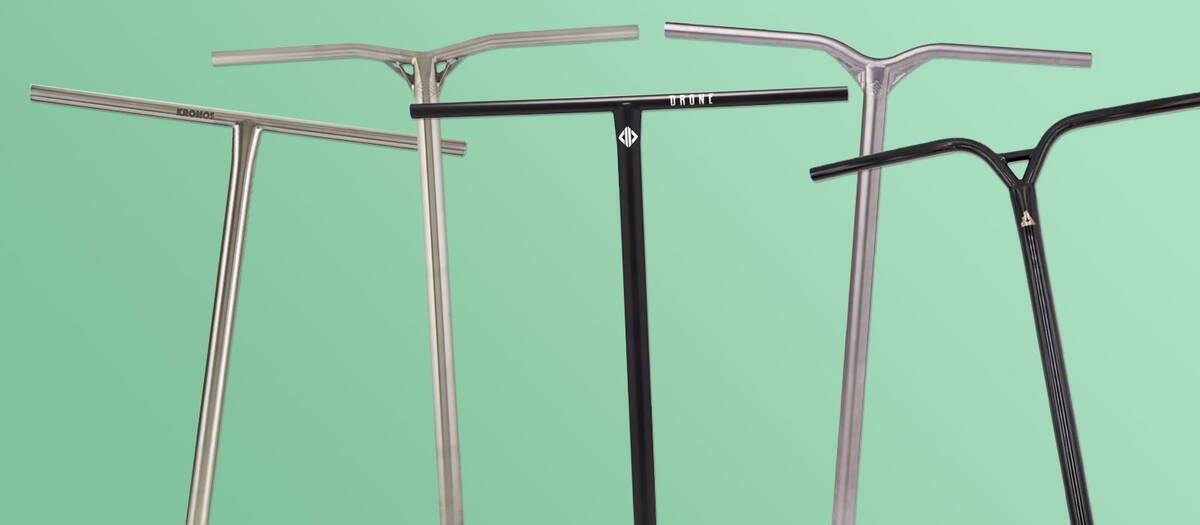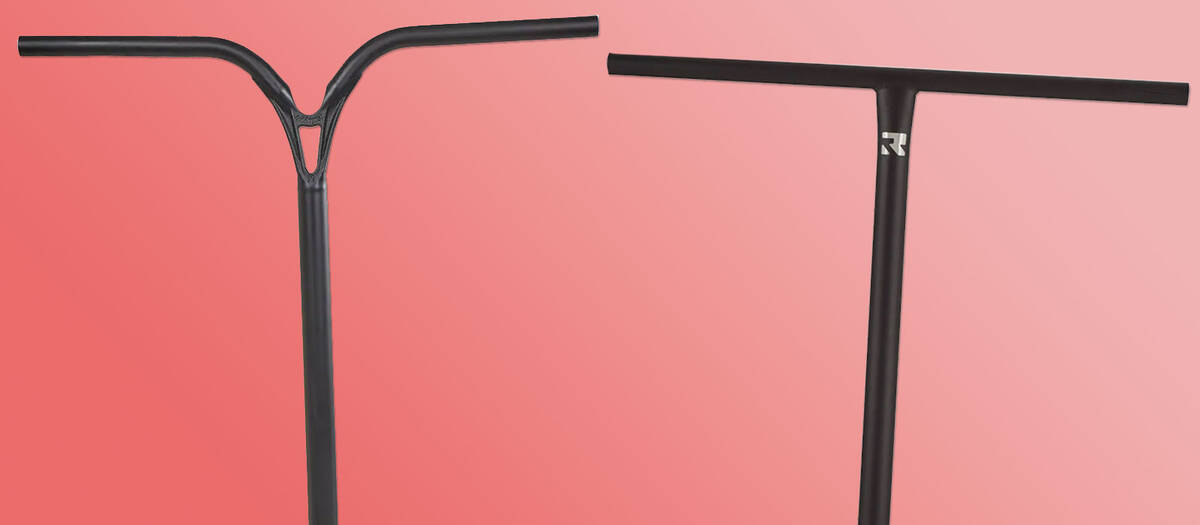Guide for Choosing Stunt Scooter Bars
We will address any inquiries you might have before acquiring a new stunt scooter bar. You will become acquainted with essential aspects such as bar height, compatibility, and bar material. Prepare yourself to enhance your scooter with the finest bar available!
Overview
Overview
Determining the Ideal Height for Your Scooter Bar

The height of a stunt scooter bar is crucial when choosing the right one. The height will greatly influence your riding style and comfort, so it is advisable to be mindful when deciding on bar height.
Primarily, bar height is a personal choice. For newcomers who haven’t yet formed their own preferences, some guidelines can facilitate selecting the appropriate bar height.
So, how tall should your scooter bars ideally be? When standing on the ground with the scooter deck between your feet, the bar should ideally reach between your hips and navel. This height ensures comfort and provides adequate leverage for performing tricks. With the bars at this level, you can ride with a straight back while maintaining ample leverage. If you’re new to scooters and find yourself choosing between two bar heights within the suggested range, opting for the taller one is generally recommended as it often grants better control.
If you're considering adjusting the size up or down when purchasing new scooter bars - or if you're uncertain whether to choose a taller or shorter variant of a particular bar - this table might assist you.
| Aspect | Taller Bars | Shorter Bars |
|---|---|---|
| Comfort | Minimises back strain due to a more upright posture | Involves bending forward, which might increase strain on the back |
| Tricks | Enhanced control over grinds and manuals | Better for manoeuvring the scooter mid-air |
| Stability | Increased stability | Offers more agility and responsiveness |
| Style | Generally street style | Commonly park style |
How to Measure the Height of a Scooter Bar
The bar height is specified in the product details when you are buying a scooter bar. This measurement alone, though, doesn't definitively indicate how tall your scooter will stand once the bar is attached.
To ascertain the total height of your scooter with the new bar installed, measure from the bottom of the front wheel to where the bottom of the scooter bar will be when fixed. The location of this point depends on your scooter's compression system.
Steps for measuring the overall scooter height:
- SCS: Measure from the bottom of the front wheel to the centre point of the clamp. Add this measurement to the bar height to determine the complete scooter bar height.
- HIC/IHC/ICS: Measure from the bottom of the front wheel to the base of the clamp. Adding this to the bar height will give you your total scooter height once the new bar is fitted.
Should you require additional details, we are happy to assist. Here are a few helpful links:
Selecting the Appropriate Scooter Bar Width

When choosing the width for your scooter bar, align it with your own shoulder width. Measure the distance across your shoulders and add an inch or two. This ensures a comfortable bar width. Bars that are too narrow might appear awkward and lead to discomfort in the wrists and shoulders. Conversely, excessively wide bars can obstruct your trick capacity, with overly separated hands also causing discomfort to the shoulders and wrists.
If debating on a narrower or broader scooter bar, consider these elements:
- Wider bars: More stability and ease in catching
- Narrower bars: Greater agility and ease in spinning
Scooter Bar Diameter: Oversized versus Standard Bars

Scooter bar diameters are categorized as either standard or oversized:
- Standard: 32 mm outer diameter / 28 mm inner diameter
- Mix: 35 mm outer diameter / 28 mm inner diameter (many aluminium bars)
- Oversized: 35 mm outer diameter / 32 mm inner diameter
The principal distinction between standard and oversized scooter bars is their weight and strength. Oversized bars are typically more robust and heavier, whereas standard-sized bars tend to be lighter and less durable.
Aluminium bars, in this context, are quite unique because they require additional material to be durable enough for heavy-duty use. Most aluminium bars available have a 35 mm outer diameter and a standard 28 mm inner diameter.
Understanding Scooter Bar Compatibility
Checking compatibility with your existing setup is crucial when choosing a new scooter bar. Look at its specifications to find out which compression system it supports.
- If using an SCS setup, ensure the bar lacks a slit - an SCS adapter can be used to remove the slit
- If you possess a standard-sized SCS clamp, your bar should have a standard outer diameter
- For those using an oversized SCS clamp with a wish to use a standard-sized SCS bar, ensure you have an appropriate SCS clamp shim
|
Compression System |
Standard Bars 32 mm outer diameter 28 mm inner diameter |
Oversized Bars
35 mm outer diameter 32 mm inner diameter |
Aluminum Bars 35 mm outer diameter 28 mm inner diameter |
|---|---|---|---|
|
SCS Scooter Bars |
Compatible if:
|
Compatible if:
|
Compatible if:
|
|
HIC Scooter Bars |
NOT COMPATIBLE |
Compatible if:
|
NOT COMPATIBLE |
|
IHC Scooter Bars |
Compatible if:
|
NOT COMPATIBLE |
Compatible if:
|
If you have an SCS setup and are attracted to a bar with a slit, you can purchase an SCS Sleeve (also known as an SCS Bar Adapter) within our Scooter Compression category, though many HIC or IHC bars come with an SCS adapter. Discover them here:
We offer various relevant guides on stunt scooter compression and the compatibility of the various parts. These guides may provide answers to your questions:
Titanium Scooter Bars

Titanium bars are as light as ones made of aluminium and robust like those fabricated from steel. Consequently, they have gained popularity amongst seasoned scooter riders. The primary reason to invest in a titanium bar for scooters is its excellent strength-to-weight ratio. With titanium, there's no concern about breaking bars during intense riding. Their lightweight nature also ensures they don't impede performance.
Compared to chromoly or aluminium, titanium is costlier, and its outstanding properties imply that creating titanium bars requires more resources. Thus, they usually have a higher price.
Riders new to titanium bars often find their flexing ability surprising. Although adapting to this flexibility might take time, it can ultimately enhance your riding experience. Embracing the flex can be advantageous as it absorbs some impact experienced during hard landings.
An additional distinction between titanium bars versus steel or aluminium ones is that titanium bars don’t gradually weaken and bend. Instead, they may snap after years of extensive use. If you notice signs of wear on your titanium bars (which typically occurs after long periods of intense use), it is prudent to replace them without delay.
Pros:- Durable
- Lightweight
- Flexibility
- Expensive
- Flexibility (some riders prefer rigidness)
- Prone to snapping upon breaking eventually.
Filter our bar selection by material to view all our titanium options:
Aluminium Scooter Bars

Aluminium stunt scooter bars are celebrated for their lightweight nature, rendering them perfect for riders prioritising agility and manoeuvrability. The lightness of aluminium bars offers a notable advantage when performing intricate air tricks and manoeuvres. Furthermore, aluminium bars are typically more budget-friendly, appealing to those seeking bars suitable for trick execution.
However, aluminium bars have a prominent drawback in their relative lack of strength. Compared to steel or titanium bars, they are more prone to bending or breaking. To counteract this, aluminium bars typically incorporate reinforcing elements like gussets or wedges at weld points to enhance structural integrity.
Pros:- Lightweight
- Affordable
- Less durable
- Rigid / not flexible
To view our range of aluminium bars, use the filter in the category by material:
Chromoly Scooter Bars

Steel stunt scooter bars, commonly referred to as chromoly bars, are greatly valued for their exceptional durability and cost-effectiveness. They do, however, weigh more than bars constructed from other materials.
In contrast to aluminium bars, which frequently feature gussets or Y-shapes for increased strength, chromoly bars can be fabricated in genuine T-shapes due to the robust nature of the material.
Street setups often utilise steel bars, favoured by professional stunt scooter riders as well. Not every rider places importance on having the lightest setup, so whether you're just starting or already a professional, chromoly stunt scooter bars offer a dependable option!
To decrease some of the additional weight, select chromoly scooter bars employ butted tubing, meaning specific sections feature thinner tubing to cut down on weight without compromising strength. Ideal for beginners, chromoly bars suit every compression system and are available in various styles.
Pros:- Durable
- Strong
- Affordable
- T-shape
- Heavy
Explore our collection of scooter bars and apply the material filter to browse through all our chromoly stunt scooter bars:
Should You Choose Y-Bars or T-Bars for Stunt Scooters?

T-bars and Y-bars are named after the unique shape they present. Selecting between them largely relates to what suits personal tastes best, as there's no definitive better choice.
Typically viewed as slightly weaker, T-bars lack gussets or supports to fortify the junction between the handlebars and the down tube, usually fabricated from steel or titanium.
Y-bars come with reinforcements, making them moderately stronger. Therefore, aluminium bars are often designed in a Y-shaped form.
Deciding between T-bars and Y-bars leans on several factors such as visual appeal, personal comfort during use, and alignment with one's style or identity as a scooter rider. Ultimately, both styles deliver distinct benefits catering to a variety of rider preferences.
Backsweep & Upsweep
Backsweep refers to the angle of the handlebar directed towards the rider, while upsweep describes the upward tilt of the bar, both significantly influencing scooter ergonomics, offering a more comfortable wrist position.
Typically, Y-shaped bars include backsweep and upsweep features, while T-shaped stunt scooter bars focus on a straightforward and simple design.
Have a look at our fantastic selection of Y-shaped and T-shaped bars:
